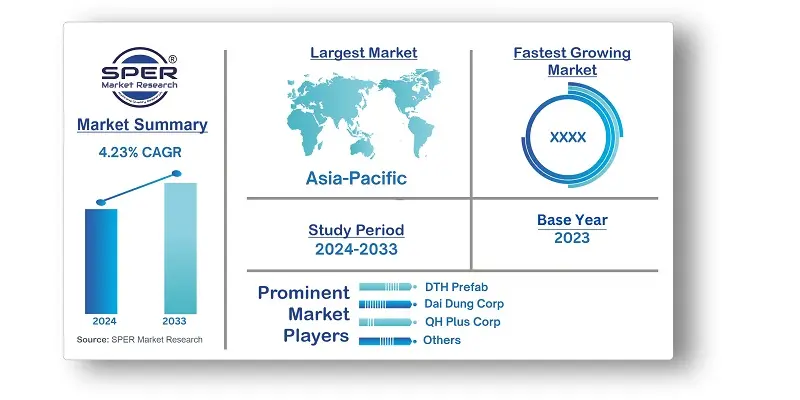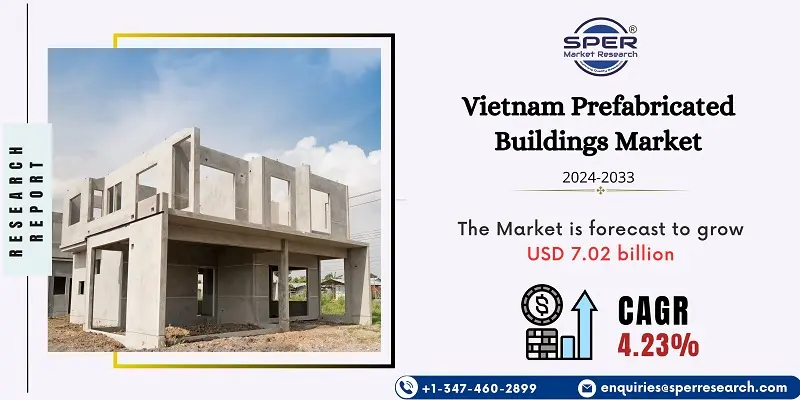
Vietnam Prefabricated Buildings Market Trends, Share, Size, Revenue, Demand and Future Outlook
Vietnam Prefabricated Buildings Market Growth, Size, Trends Analysis– By Material Type, By Application- Regional Outlook, Competitive Strategies and Segment Forecast to 2033
| Published: Nov-2024 | Report ID: COAM2441 | Pages: 1 - 109 | Formats*: |
| Category : Construction & Manufacturing | |||
- In August 2023, Vietnam inaugurated its largest 3D printing factory in Ho Chi Minh City. This workshop covered a variety of functional areas and professional processes and was formally opened in the city by 3D Smart Solutions (3DS) Co. Ltd., which contributed to increased income in the Vietnam building market.
- In September 2022, Lotte Group, a prominent South Korean retail company, revealed plans to build an environmentally sustainable'smart city' complex and a'smart logistics' center in Vietnam.


| Report Metric | Details |
| Market size available for years | 2020-2033 |
| Base year considered | 2023 |
| Forecast period | 2024-2033 |
| Segments covered | By Material Type, By Application |
| Regions covered | North Vietnam, South Vietnam, East Vietnam, West Vietnam |
| Companies Covered | Zamil Steel Buildings Vietnam Co. Ltd, DTH Prefab, Dai Dung Corp, TLC Modular, Lien Son Thang Long Joint Stock Company, Steel Buildings and Equipment Industries JSC, QH Plus Corp, Tran Duc Corp. |
- Real Estate Developers
- Construction Companies and Contractors
- Government and Public Sector Agencies
- Industrial Facility Owners
- Residential Homebuyers
- Architects and Engineers
- Retail and Commercial Property Owners
- Hospitality Sector (hotels and resorts)
- Educational and Healthcare Institutions
- Manufacturers of Prefabricated Building Components
- Distributors and Suppliers of Building Materials
| By Material Type: | |
| By Application: | |
| By Region: |
- Vietnam Prefabricated Buildings Market Size (FY’2024-FY’2033)
- Overview of Vietnam Prefabricated Buildings Market
- Segmentation of Vietnam Prefabricated Buildings Market By Material Type (Concrete, Glass, Metal, Timber, Others)
- Segmentation of Vietnam Prefabricated Buildings Market By Application (Residential, Commercial, Industrial)
- Statistical Snap of Vietnam Prefabricated Buildings Market
- Expansion Analysis of Vietnam Prefabricated Buildings Market
- Problems and Obstacles in Vietnam Prefabricated Buildings Market
- Competitive Landscape in the Vietnam Prefabricated Buildings Market
- Impact of COVID-19 and Demonetization on Vietnam Prefabricated Buildings Market
- Details on Current Investment in Vietnam Prefabricated Buildings Market
- Competitive Analysis of Vietnam Prefabricated Buildings Market
- Prominent Players in the Vietnam Prefabricated Buildings Market
- SWOT Analysis of Vietnam Prefabricated Buildings Market
- Vietnam Prefabricated Buildings Market Future Outlook and Projections (FY’2024-FY’2033)
- Recommendations from Analyst
1.1. Scope of the report1.2. Market segment analysis
2.1. Research data source
2.1.1. Secondary Data2.1.2. Primary Data2.1.3. SPER’s internal database2.1.4. Premium insight from KOL’s
2.2. Market size estimation
2.2.1. Top-down and Bottom-up approach
2.3. Data triangulation
4.1. Driver, Restraint, Opportunity and Challenges analysis
4.1.1. Drivers4.1.2. Restraints4.1.3. Opportunities4.1.4. Challenges
4.2. COVID-19 Impacts of the Vietnam Prefabricated Buildings Market.
5.1. SWOT Analysis
5.1.1. Strengths5.1.2. Weaknesses5.1.3. Opportunities5.1.4. Threats
5.2. PESTEL Analysis
5.2.1. Political Landscape5.2.2. Economic Landscape5.2.3. Social Landscape5.2.4. Technological Landscape5.2.5. Environmental Landscape5.2.6. Legal Landscape
5.3. PORTER’s Five Forces
5.3.1. Bargaining power of suppliers5.3.2. Bargaining power of buyers5.3.3. Threat of Substitute5.3.4. Threat of new entrant5.3.5. Competitive rivalry
5.4. Heat Map Analysis
6.1. Vietnam Prefabricated Buildings Market Manufacturing Base Distribution, Sales Area, Product Type6.2. Mergers & Acquisitions, Partnerships, Product Launch, and Collaboration in Vietnam Prefabricated Buildings Market
7.1. Vietnam Prefabricated Buildings Market Size, Share and Forecast, By Material Type, 2020-20267.2. Vietnam Prefabricated Buildings Market Size, Share and Forecast, By Material Type, 2027-20337.3. Concrete7.4. Glass7.5. Metal7.6. Timber7.7. Others
8.1. Vietnam Prefabricated Buildings Market Size, Share and Forecast, By Application, 2020-20268.2. Vietnam Prefabricated Buildings Market Size, Share and Forecast, By Application, 2027-20338.3. Residential8.4. Commercial8.5. Industrial
9.1. Vietnam Prefabricated Buildings Market Size and Market Share
10.1. Vietnam Prefabricated Buildings Market Size and Market Share By Region (2020-2026)10.2. Vietnam Prefabricated Buildings Market Size and Market Share By Region (2027-2033)10.3. North Vietnam10.4. South Vietnam10.5. East Vietnam10.6. West Vietnam
11.1. Zamil Steel Buildings Vietnam Co. Ltd
11.1.1. Company details11.1.2. Financial outlook11.1.3. Product summary11.1.4. Recent developments
11.2. DTH Prefab
11.2.1. Company details11.2.2. Financial outlook11.2.3. Product summary11.2.4. Recent developments
11.3. Dai Dung Corp
11.3.1. Company details11.3.2. Financial outlook11.3.3. Product summary11.3.4. Recent developments
11.4. TLC Modular
11.4.1. Company details11.4.2. Financial outlook11.4.3. Product summary11.4.4. Recent developments
11.5. Lien Son Thang Long Joint Stock Company
11.5.1. Company details11.5.2. Financial outlook11.5.3. Product summary11.5.4. Recent developments
11.6. Steel Buildings and Equipment Industries JSC
11.6.1. Company details11.6.2. Financial outlook11.6.3. Product summary11.6.4. Recent developments
11.7. QH Plus Corp
11.7.1. Company details11.7.2. Financial outlook11.7.3. Product summary11.7.4. Recent developments
11.8. Tran Duc Corp
11.8.1. Company details11.8.2. Financial outlook11.8.3. Product summary11.8.4. Recent developments
11.9. Others
SPER Market Research’s methodology uses great emphasis on primary research to ensure that the market intelligence insights are up to date, reliable and accurate. Primary interviews are done with players involved in each phase of a supply chain to analyze the market forecasting. The secondary research method is used to help you fully understand how the future markets and the spending patterns look likes.
The report is based on in-depth qualitative and quantitative analysis of the Product Market. The quantitative analysis involves the application of various projection and sampling techniques. The qualitative analysis involves primary interviews, surveys, and vendor briefings. The data gathered as a result of these processes are validated through experts opinion. Our research methodology entails an ideal mixture of primary and secondary initiatives.



Frequently Asked Questions About This Report
PLACE AN ORDER
Year End Discount
Sample Report
Pre-Purchase Inquiry
NEED CUSTOMIZATION?
Request CustomizationCALL OR EMAIL US
100% Secure Payment






Related Reports
Our Global Clients
Our data-driven insights have influenced the strategy of 200+ reputed companies across the globe.




















